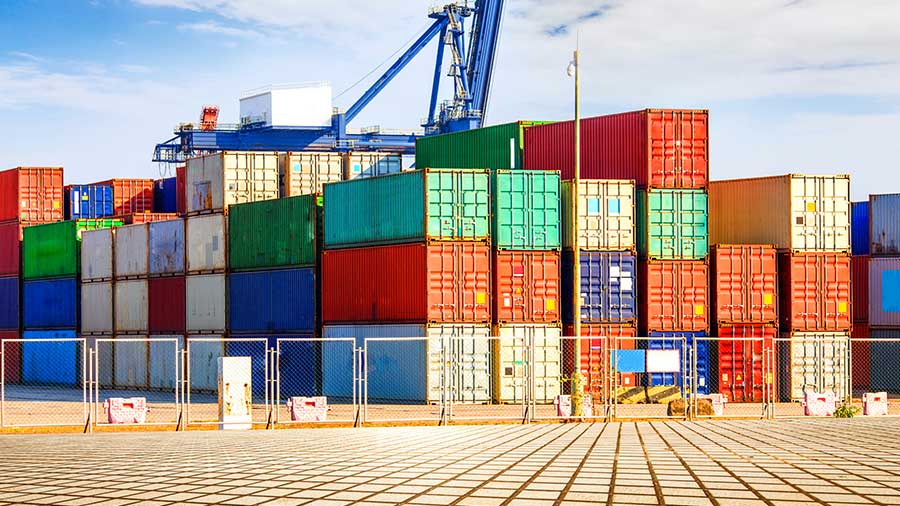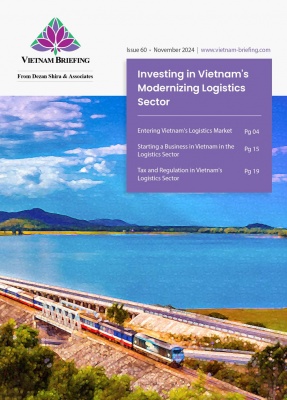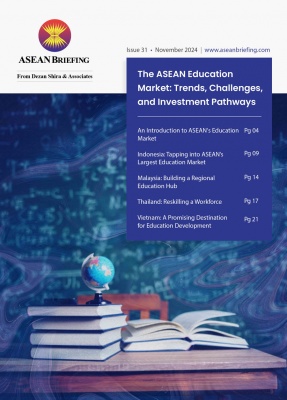China’s Manufacturing Presence in Vietnam: Locations and Future Growth
China’s manufacturing presence in Vietnam is experiencing dynamic growth, fueled by robust investments and Vietnam’s advantages as a production hub. Numerous Chinese companies are establishing factories in the country to expand their operations, optimize supply chains, and enhance access to Southeast Asian markets. This article examines the scale of Chinese investments and their concentrations in Vietnam’s key manufacturing hubs.
China’s FDI in Vietnam
China remains one of the largest foreign investors in Vietnam, with increasing investments. In 2024, Chinese firms recorded total investments of US$4.73 billion in Vietnam, raising the total since 1988 to US$30.83 billion. Along with Singapore and South Korea, the nation ranked among Vietnam’s top three investors in 2024, experiencing a 3.1 percent increase in investments compared to 2023. Furthermore, China also led in Vietnam’s new investment projects, representing 28.3 percent of all the newly registered initiatives.
Vietnam’s manufacturing and processing sector remains the largest recipient of foreign investment, with key industries including:
- Electronics: Major Chinese technology firms, such as Luxshare and Goertek, are expanding their production in Vietnam, capitalizing on its skilled workforce and growing industrial base. As companies diversify their supply chains, Vietnam’s role in midstream electronics manufacturing continues to expand.
- Textiles & Garments: Chinese textile giants, such as Shenzhou, continue to invest in fabric and apparel factories, bolstering Vietnam’s growing export sector by leveraging its trade access to Western markets.
- Machinery & Industrial Equipment: Chinese firms, such as BOE and Victory Giant Technology, are increasing their investments in Vietnam’s industrial machinery sector, thereby enhancing both domestic manufacturing and exports.
This growing demand is bolstered by Vietnam’s strategic geographic proximity to Chinese-speaking regions, including Mainland China, Singapore, Taiwan, and Hong Kong. Strong trade ties and integration into global supply chains further enhance its appeal, making Vietnam a natural extension of China’s manufacturing ecosystem. China’s growing FDI footprint in Vietnam reflects a strategic shift in global supply chains, positioning Vietnam as a key manufacturing and export hub in the region.
Vietnam’s attractiveness to Chinese manufacturing firms
Vietnam has become one of the leading destinations for FDI, attracting capital from over 110 countries. This rising trend is influenced by its strategic location, an attractive labor market, and supportive policies.
With its strategic location, business-friendly policies, and growing workforce, Vietnam has become a key destination for Chinese and global investors. The country continues to attract investment in electronics, solar panels, and high-tech manufacturing due to trade agreements and competitive production costs. As global supply chains shift, particularly amid U.S.-China trade tensions, more Chinese manufacturers are expanding their operations in Vietnam. This strengthens Vietnam’s position as a major manufacturing hub. In February 2025, Vietnam’s manufacturing PMI reached 49.2, showing steady industrial growth and increasing importance in global trade.
Also read: Vietnam Manufacturing Tracker: 2024-25
Beneficial geographic position
Vietnam’s geographic position enhances its role as a global manufacturing hub. The country shares a long land border with China, facilitating seamless supply chain integration while diversifying production. Additionally, its 3,260 km coastline and central location in Southeast Asia grant easy access to major global shipping routes, making it ideal for export-driven industries. Vietnam also boasts 36 airports (12 of which are international) and 320 seaports and river ports (163 of which are international), which enable efficient trade and logistics operations.
Abundant labor market
Vietnam’s labor market is both competitive and increasingly skilled. With a workforce of 53 million, the country provides a large and cost-effective labor pool compared to its regional counterparts. Despite rising minimum wages, Vietnam’s average monthly salary was US$302 in 2024, which remains considerably lower than those of Malaysia (US$790) and Thailand (US$427). Additionally, Vietnam holds the second-highest position in the region in terms of PISA scores regarding workforce capabilities. Over the past five years, labor productivity has grown steadily at a CAGR of 3.6 percent, nearly double the ASEAN average of 2 percent.
Supportive trade policies and economic strategies
Third, Vietnam’s trade policies and economic approach promote long-term investments. By 2025, the country is expected to have signed 17 free trade agreements (FTAs) and fostered positive global relations through its “Bamboo Diplomacy.”
This strategy facilitates trade with key markets and instills stability and confidence for foreign businesses seeking long-term success. Additionally, foreign investors, particularly those in high-tech and priority sectors, can take advantage of tax incentives or industry-specific benefits when establishing operations in Vietnam.
Locations of Chinese manufacturing businesses in Vietnam
Unlike many other FDI enterprises that concentrate in major urban centers like Ho Chi Minh City (HCMC) and Hanoi, Chinese investors are more evenly distributed across various provinces in Vietnam. Binh Duong, Quang Ninh, and Long An each host 7 percent of Chinese enterprises, while emerging industrial hubs in the north, such as Bac Giang, Hai Duong, and Hai Phong, each account for 6 percent. This north-south industrial divide is shaped by differences in geography, supply chain integration, and labor dynamics.
|
Key Manufacturing Hubs for Chinese Investment in Vietnam |
|||
|
Region |
Key Provinces |
Industry Focus |
Notable Companies |
|
North |
Bac Ninh, Hai Phong, Bac Giang, Phu Tho |
High-tech, precision manufacturing |
Luxshare, Goertek, BOE, BYD,… |
|
South |
Binh Duong, Dong Nai |
Labor-intensive industries, large-scale production |
Shenzhou International, Changshin,… |
This north-south divide highlights Vietnam’s varying industrial strengths, with northern hubs concentrating on precision manufacturing and exports, whereas southern hubs focus on large-scale, labor-intensive industries. These structural differences are significant factors for foreign companies to consider when positioning their supply chains to capitalize on the advantages of each region.
Vietnam’s Northern hubs benefit from proximity to China
Northern Vietnam has rapidly emerged as a high-tech, export-oriented center, facilitated by its proximity to China, extensive logistics infrastructure, and robust government-supported industrial zones. Key industrial centers, such as Bac Ninh, Hai Phong, Bac Giang, and Phu Tho, are notable in this development. Bac Ninh, in particular, hosts prominent Chinese electronics manufacturers, such as Luxshare and Goertek, making it a vital part of Apple’s supply chain. Hai Phong benefits from a deep-sea port and a comprehensive logistics network, serving as the operational base for BOE, a major Chinese display manufacturer that supplies global tech companies.
Additionally, BYD, a major Chinese player in the automotive and electronics sectors, has invested nearly US$600 million in Phu Tho, thereby enhancing the province’s significance in these areas. Over the last decade, the North has experienced considerable change, attracting high-tech and capital-intensive projects. Significant tech giants, including Samsung, LG, Amkor, and Foxconn, have established large-scale operations here, bringing along a network of suppliers and R&D initiatives. With modern road networks and government-backed industrial parks, the North remains a prime location for high-tech manufacturing and precision industries.
Also read: Key Industrial Parks in Northern Vietnam
Southern Vietnam stands firm as an advanced industrial hub
Throughout recent decades, the South of Vietnam has remained the country’s most vibrant economic zone, gaining an advantage from its early industrial development start, a sizable labor force, and a mature business ecosystem that promotes the manufacturing, retail, and e-commerce sectors. Binh Duong and Dong Nai, located near HCMC, are key industrial provinces.
Spanning 2,694 square kilometers, Binh Duong ranks third in terms of GDP contributions and has emerged as a focal point for industrial activities, attracting significant investments from Chinese manufacturers. The textile leader Shenzhou International operates major fabric and apparel facilities in this province, serving global brands such as Nike and Adidas.
Meanwhile, Dong Nai is evolving into a burgeoning hub for Chinese electronics and automotive component producers, bolstered by infrastructure improvements and the expected completion of Long Thanh International Airport in 2026. The South remains a hub for labor-intensive industries, such as textiles and footwear, supported by a large, cost-effective workforce and a rich history of industrial development.
With well-developed export networks and thriving business sectors, Vietnam’s southern provinces and cities consistently attract companies seeking efficient, large-scale production capabilities. These structural differences influence where manufacturers choose to establish operations, with global firms strategically positioning their supply chains to capitalize on each region’s strengths.
Also read: Vietnam’s Dong Nai Province: Investment Hub of the South
Implications for businesses
The expansion of China’s manufacturing operations in Vietnam highlights the evolution of global supply chains. With significant investments, advantageous trade conditions, and a talented labor force, Vietnam has become a crucial center for both Chinese manufacturers and international investors.
In the North, high-tech sectors can leverage a skilled workforce, state-of-the-art industrial parks, and efficient supply chain linkages with China. Major global tech companies are already established there, creating opportunities for businesses in electronics, semiconductors, and industrial equipment to thrive within a robust supplier network.
In the South, industries that rely on large-scale and cost-effective production benefit from established business infrastructures and a strong labor market. Binh Duong’s clusters in textiles and electronics, together with Dong Nai’s growing industrial scene, are particularly well-suited for mass production and supply chain integration. By recognizing these regional strengths, firms can strategically determine where to establish operations, resulting in improved efficiency, reduced costs, and enhanced access to essential supply chains.
As Vietnam enhances its role in international trade, continuous infrastructure upgrades and supportive policies will further reinforce its status as a top manufacturing hub in Southeast Asia.
About Us
Vietnam Briefing is published by Asia Briefing, a subsidiary of Dezan Shira & Associates. We produce material for foreign investors throughout Asia, including ASEAN, China, and India. For editorial matters, contact us here and for a complimentary subscription to our products, please click here. For assistance with investments into Vietnam, please contact us at vietnam@dezshira.com or visit us at www.dezshira.com.
Dezan Shira & Associates assists foreign investors throughout Asia from offices across the world, including in Hanoi, Ho Chi Minh City, and Da Nang. We also maintain offices or have alliance partners assisting foreign investors in China, Hong Kong SAR, Dubai (UAE), Indonesia, Singapore, Philippines, Malaysia, Thailand, Bangladesh, Italy, Germany, the United States, and Australia.
- Previous Article Vietnam’s Booming ICT Market Expands Opportunities for Foreign Investment
- Next Article Vietnam-Australia Strengthen Development Partnership 2025-2030































